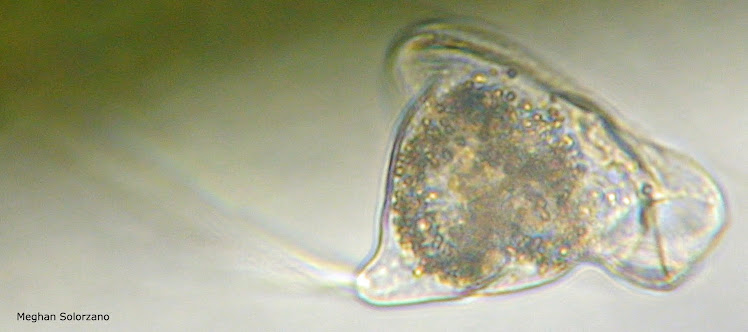Patterson, D.J.. Free-living Freshwater Protozoa. London, NW11 7DL, UK: Manson Publishing, 1992.
Ward, Henry B., and George C. Whipple. Fresh-water Biology. London: New York, John Wiley & sons, inc, 1918.
Donner, Josef. Rotifers. Warne, London: H G S Wright, 1966.
The picture at the top of the blog is of a Vorticella. It was named from figure 232-236, page 113 of Free-living Freshwater Protozoa.
The two pictures on the bottom right are of Coleps which were found in Free-living Freshwater Protozoa on page 163 and the Paramecium Barsuria was locating in the same book on page 155.
The picture on the bottom left is of the Lecane sp. found in Rotifers, fifure 8-62, page 56.
The picture of the flatworm (stenostomum) was named from Fresh-water Biology figure 594, page 336.
The lecane sp. Rotifer was found in Rotifers, fifure 8-62, page 56.
The Euplote was found in Free-living Freshwater Protozoa figure 259-61, page 124.
The Coleps was found in Free-living Freshwater Protozoa on page 163 and the Paramecium Barsuria was locating in the same book on page 155.

Sunday, November 21, 2010
Tuesday, November 16, 2010
Week 4
Things changed a lot this past week in my tank. The Rodifers (the little round things) have almost disappeared entirely. They were swarming the place last week. I cannot figure out what has happened to them. I'm quite disappointed that the activity levels have decreased so much. I was enjoying all the different organisms bouncing around. I was able to find some amoeba still but was unable to find my flatworm. That too was not a great thing. The flatworm was my most favorite organism. I really hope he was just hiding out and hasn't died. The water in the aquarium has gone down as well. I'm not sure if it is evaporating or if someone knocked it over. I'm fairly certain evaporation is the cause.
Friday, November 5, 2010
Week 3 (Video)
Update: The video does not seem to be working. I have put it up on youtube and it's doing just fine there. Here's the link: http://www.youtube.com/watch?v=V74Z3slh7JQ
This is the first video I have ever edited. Sorry for any glitchy moments. I had some great video of a nematode, however, I cut it out for length puproses. I'll make a second video later.
Things have changed a bit this week in my aquarium. There is still quite a bit of activity, however, it has lessened greatly from last week. I did find a new organism called a stenostomum (Ward, H.B, 1918 Fig. 594). I will try to add more to this week's discoveries soon. I'm going to look up the previous organisms now though. I've been here for 2 and a half hours just to provide you with what little you see so far.
Thursday, November 4, 2010
Week 2
Dr. McFarland added a food pellet to my tank. This has caused a major change in the environment. I had taken a look at my tank during week one to find it to be, what I thought, very active. However, after the addition of the food pellet the term "active" does not even begin to describe the changes. Before I even had a chance to focus the lens I could see brown specs swarming all over the place. Once I was in focus I could see that the population in the MicroAquariam had increased immensely.
Last week the organisms seemed a bit lazy, now it's a circus. Taking pictures proved difficult. Many of the little organisms refused to stop and pose for pictures. I did find a very interesting worm in the tank that Dr. McFarland said was a 'Flat Worm." I will be spending more time during week 3 for research (this will be tomorrow). I keep spending all my time with my nose in the microscope rather than the books. Today, I will provide a few more pictures of the things I saw and I will come back to update the names of all of them.
I have also found out the types of plants that I added to the aquarium; plant A is Fontinalis and plant B is Uticularia. Currently the microorganisms are seeming to enjoy both. Although, the Uricularia may be getting a bit more attention.
This is the Flatworm Dr. McFarland mentioned.
Stenestomum sp.
(Fresh-water Biology, 594)
Stenestomum sp.
(Ward, 594)
Euplote
(Patterson, 124)
Dr. McFarland said this was an amoeba. It was one of the most awesome things I have ever seen. The little balls move inside of the gelatin layer almost as if they are waves passing over one another and this is how the entire unit moves.
Amoeba
(Baldwin)
And these are the little things that swarmed all over the place. I took this during a feeding frenzy on one of the plants. I will give you more information about how the move and what they are very soon.
Colepse
(Hedley, 163)
Food Pellet Information:
"Atison's Betta Food" made by Ocean Nutrition, Aqua Pet Americas, 3528 West 500 South, Salt Lake City, UT 84104. Ingredients: Fish meal, wheat flower, soy meal, krill meal, minerals, vitamins and preservatives. Analysis: Crude Protein 36%; Crude fat 4.5%; Crude Fiber 3.5%; Moisture 8% and Ash 15%.
Subscribe to:
Comments (Atom)




